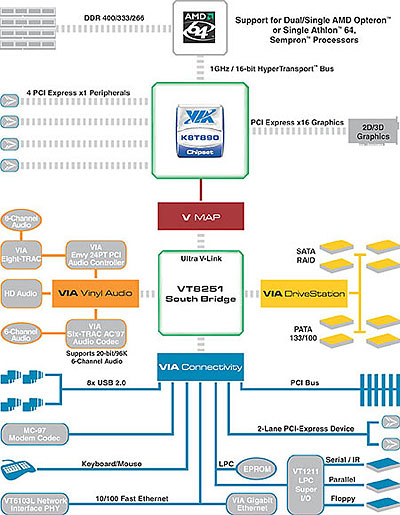VIA's new K8T890 chipset is built for the Socket 939
AMD Athlon64/Athlon64 FX processor, and features a 1 GHz HyperTransport connection (16 bits up /
downstream) between the CPU and Northbridge. There are a total of 20 PCI Express lanes
available in the K8T890 too; 16 lanes are set aside for the graphics card
and the four remaining lanes can be split into four PCI Express
x1 slots, or one PCI Express x4 slot for extra high bandwidth devices.

Connecting the K8T890 Northbridge
and VT8237 Southbridge is VIA's Ultra V-Link bus which has a total of 1066MB/s bandwidth.
The VT8237R includes support for Serial ATA with RAID modes 0,
1 and 0+1 when used in conjunction with a SATAlite controller.

Eight USB 2.0 ports are integrated into
the Southbridge as well as support for up to six 32bit PCI slots. There's a
direct connection to the Southbridge for 10/100 or Gigabit ethernet controllers
which mean they do not have to run through the PCI bus.
mPower, no it's not a BMW...
 When using the Albatron K8X890 Pro II, you can install an
additional VRM (Voltage Regulator Module) that works with the motherboard's
onboard power circuits. When attached, the mPower VRM should help the
motherboard provide cleaner, more stable power to the processor and other
components attached to the board.
When using the Albatron K8X890 Pro II, you can install an
additional VRM (Voltage Regulator Module) that works with the motherboard's
onboard power circuits. When attached, the mPower VRM should help the
motherboard provide cleaner, more stable power to the processor and other
components attached to the board.
Another added benefit is that the mPower module
will lower the operating temperatures of the MOSFETs on the motherboard.
Connecting and configuring the motherboard to use the
mPower VRM module is a bit more difficult than it really should be. According to
the manual you must set four jumpers properly, otherwise it's possible to damage
both the mPower module and the board! We took Albatron's word and set the
jumpers accordingly.
o do that however, you'll need to refer to the user
manual. There is a label on the motherboard but at first it's not clear what
'PWM4' is (that's the mPower VRM module).
 Cleaner more stable power is a great idea and
hopefully Albatron can implement it better on future motherboards. A simple plug and play method
would be best if possible, as Gigabyte has done on many of its
enthusiast-level platforms.
Cleaner more stable power is a great idea and
hopefully Albatron can implement it better on future motherboards. A simple plug and play method
would be best if possible, as Gigabyte has done on many of its
enthusiast-level platforms.
Overclocking and
Albatron
Albatron
has always been good to the enthusiast and supported overclocking. They've
produced some of the faster motherboards out there, so we were anticipating good
things from the K8X890 Pro II.
As usual we begin overclocking
by lowering the clock multiplier of the processor to 6x, and set the memory to run in 133 MHz
mode; this way neither the processor or RAM limits the motherboard in overclocking.
Starting
at 200 MHz Front Side Bus, we raised the clock speed 5 MHz at a
time. At 235 MHz FSB, the K8X890 Pro II started having a hard time loading WindowsXP.
Raising the Northbridge voltage by 0.2V helped stabilize it.
It
encountered more stability issues around 252 MHz,
and at anything higher the board simply refused to POST. I'm not sure
what the problem was exactly, but since raising the voltage a bit more didn't help,
I suspect the culprit might be heat. The passive heatsink on the K8T890 chipset
was very hot to the touch, so perhaps with better northbridge cooling this board
could go further.
Still,
getting 252 MHz out of this K8T890-based motherboard was
still pretty impressive. It's nice to see that VIA
boards can overclock well, and that Albatron is upholding their well earned reputation.
